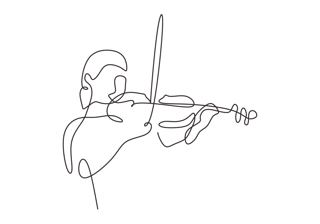8 Steps for Productive Practice
1) Set a time
Make practicing a routine. Choose a time of day that you can reliably set aside for practicing. For example: right after school, before breakfast, after dinner, etc.
2) Stay consistent
Consistency is key. You are more likely to keep up your practice routine if you are consistent. Even if you only practice for 5 minutes one day, don't skip as this will break your routine.
3) Set up your space
Create a dedicated space to practice. Make the space inviting, inspiring and distraction free. Setting up and breaking down is tedious and takes away from practice time. The space can be a simple set up, a chair and stand in a corner with a basket or organizer bin with your music and accessories. Things I like to keep in my practice space: music stand, chair, sheet music, pencil, practice journal and coaster for a mug of tea.
4) Prepare your mind
Before playing, hold your instrument and focus your mind on what you are about to do. This is called visualization and is utilized by top athletes and performers around the world. Building these 30 seconds of “meditation” into your daily practice will help prepare you for any stressful moment: performance days, auditions, or even during practice while attempting a new skill.
5) Create your practice plan
To maximize your practice time, write down in your practice journal what you intend to practice and how much time you will allot. Specific, measurable goals will lead to intentional, focused practice. Instead of setting a goal like "practice 30 minutes a day" write out a plan like the following:
30-minute practice routine:
- Scales – 5 minutes
- Technique – 5 minutes
- Review & practice notes from last session – 10 minutes
- New piece – 10 minutes
6) Set specific goals
To create a successful practice plan, make a checklist of specific goals. I like to use small sticky notes to quickly highlight spots in my music that need extra work. At the end of your practice session, make note of those spots in your practice journal for the next session. See if there is a theme of the places you need work, and set that skill as your goal. For example: are you consistently missing a shift into 4th position in multiple places? Is the articulation at the beginning of your note not quite clear? Are you consistently forgetting to vibrate your 1st finger? Make note of these general technique issues and add this to your “5-minute Techqniue” section of your practice time.
7) Set long term goals
Set long term goals to stay motivated! Perhaps you want to finish a book level, or join your local youth orchestra. Perhaps you are preparing for a recital or concert or are auditioning for a competition.
Whatever you goal is, share it with your teacher so they can help create a plan. You don’t need to have a huge goal in order to be successful. You define your own success and use your goals as motivation to improve. Remember goals can change! The audition you were preparing for may spark an idea for a recital. Be open to your unique artistic journey!
8) Recognize your progress
Practicing a fine art is like drops of water in a bucket. You don't always see how full that bucket is until you stop to take a moment to acknowledge the wonderful progress you have made. Don't be discouraged if you aren't seeing immediate results. Sticking to consistent, efficient practice will pay off. Be sure to give yourself credit and praise for all you have accomplished, to fuel yourself for your new set of goals!
How is your practice going? Comment below and subscribe to receive my studio practice chart for free!
Written by: Christina Knudson
Updated: June 29, 2023
